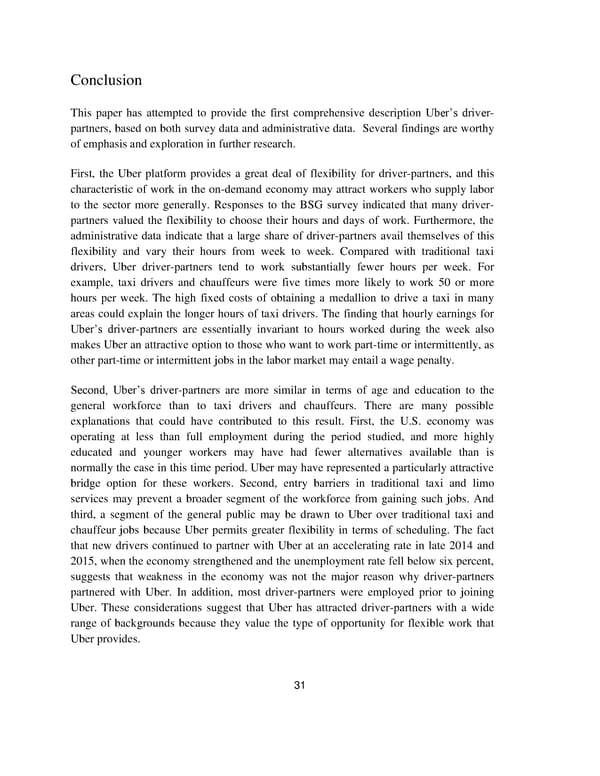Conclusion This paper has attempted to provide the first comprehensive description Uber’s driver- partners, based on both survey data and administrative data. Several findings are worthy of emphasis and exploration in further research. First, the Uber platform provides a great deal of flexibility for driver-partners, and this characteristic of work in the on-demand economy may attract workers who supply labor to the sector more generally. Responses to the BSG survey indicated that many driver- partners valued the flexibility to choose their hours and days of work. Furthermore, the administrative data indicate that a large share of driver-partners avail themselves of this flexibility and vary their hours from week to week. Compared with traditional taxi drivers, Uber driver-partners tend to work substantially fewer hours per week. For example, taxi drivers and chauffeurs were five times more likely to work 50 or more hours per week. The high fixed costs of obtaining a medallion to drive a taxi in many areas could explain the longer hours of taxi drivers. The finding that hourly earnings for Uber’s driver-partners are essentially invariant to hours worked during the week also makes Uber an attractive option to those who want to work part-time or intermittently, as other part-time or intermittent jobs in the labor market may entail a wage penalty. Second, Uber’s driver-partners are more similar in terms of age and education to the general workforce than to taxi drivers and chauffeurs. There are many possible explanations that could have contributed to this result. First, the U.S. economy was operating at less than full employment during the period studied, and more highly educated and younger workers may have had fewer alternatives available than is normally the case in this time period. Uber may have represented a particularly attractive bridge option for these workers. Second, entry barriers in traditional taxi and limo services may prevent a broader segment of the workforce from gaining such jobs. And third, a segment of the general public may be drawn to Uber over traditional taxi and chauffeur jobs because Uber permits greater flexibility in terms of scheduling. The fact that new drivers continued to partner with Uber at an accelerating rate in late 2014 and 2015, when the economy strengthened and the unemployment rate fell below six percent, suggests that weakness in the economy was not the major reason why driver-partners partnered with Uber. In addition, most driver-partners were employed prior to joining Uber. These considerations suggest that Uber has attracted driver-partners with a wide range of backgrounds because they value the type of opportunity for flexible work that Uber provides. 31
 An Analysis Of The Labor Market For Uber’s Driver-partners In The United States Page 31 Page 33
An Analysis Of The Labor Market For Uber’s Driver-partners In The United States Page 31 Page 33